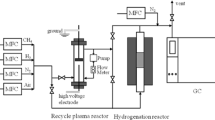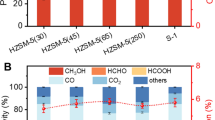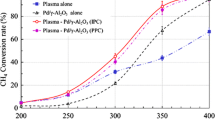Abstract
Oxidative coupling of methane in the presence of corona discharge plasma has been studied for the production of higher hydrocarbons under the conditions of ambient temperature and atmospheric pressure. The corona discharge was created by applying 3 kV (DC) between a tip and a plate electrode, 1.5 and 2.5 mm apart, in a tubular reactor. The effects of variables such as methane to oxygen ratio, total flow rate, electric current and more importantly, electrode gap distance were investigated. The electrode gap distance affected the electric field strength and subsequent plasma reactions. Five electrodes shaped like needles in the tip plate were applied to create more discharge intensity. At CH4/O2 ratio = 4, total flow rate = 4 mL/min, electric current = 10 mA and electrode gap distance = 1.5 mm, 31.9, 58 and 55 % of C2 yield, C2 selectivity and methane conversion, respectively were achieved. The main products were ethane, ethylene, acetylene, while CO and CO2 were also observed. The corona discharge interaction with HY-zeolite catalyst has led to low temperature methane conversion. Thus, the effect of surface modified zeolite catalyst was also examined. At a CH4/O2 ratio of 4 and total flow rate of 4 mL/min, 59.4, 69.7 and 85.3 %, of C2 yield, C2 selectivity and methane conversion, respectively were achieved. Experimental results revealed that corona discharge techniques, in the presence of HY-zeolite catalyst, has potentials for improving methane conversion, C2 selectivity and C2 yield.









Similar content being viewed by others
References
Li M, Xu G, Tian Y, Chen L, Fu H (2004) Carbon dioxide reforming of methane using DC corona discharge plasma reaction. J Phys Chem A 108:1687–1693
Khassin A, Pietruszka B, Heintze M, Parmon V (2004) The impact of a dielectric barrier discharge on the catalytic oxidation of methane over Ni-containing catalyst. Reac Kinet Mech Cat Lett 82:131–137
Wan YJ, Fan X, Zhu TL (2011) Removal of low-concentration formaldehyde in air by DC corona discharge plasma. Chem Eng J 171:314–319
Janda M, Morvova M, Machala Z, Morva I (2008) Study of plasma induced chemistry by DC discharges in CO2/N2/H2O mixtures above a water surface. Orig Life Evol Biosph 38:23–35
Song S-H, Park J, Chang T-S, Suh J-K (2013) Enhancing effects on the catalytic performance during the preparation of nickel supported lanthanum–alumina catalyst for the catalytic carbon dioxide dry reforming of methane. Reac Kinet Mech Cat 108:161–171
Li D, Li X, Bai M, Tao X, Shang S, Dai X et al (2009) CO2 reforming of CH4 by atmospheric pressure glow discharge plasma: a high conversion ability. Int J Hydrog Energy 34:308–313
Indarto A, Choi JW, Lee H, Song HK (2008) Decomposition of greenhouse gases by plasma. Environ Chem Lett 6:215–222
Ghose R, Hwang HT, Varma A (2014) Oxidative coupling of methane using catalysts synthesized by solution combustion method: catalyst optimization and kinetic studies. Appl Catal A Gen 472:39–46
Vandenbulcke L, de Persis S, Gries T, Delfau JL (2012) Molecular beam mass spectrometry and kinetic modelling of CH4–CO2–H2O plasmas for syngas production. J Taiwan Inst Chem Eng 43:724–729
Linga Reddy E, Biju VM, Subrahmanyam C (2012) Production of hydrogen and sulfur from hydrogen sulfide assisted by nonthermal plasma. Appl Energy 95:87–92
Benlounes O, Cheknoun S, Mansouri S, Rabia C, Hocine S (2011) Catalytic activation of C–H bonds of hydrocarbons by heteropolycompounds. J Taiwan Inst Chem Eng 42:132–137
Lee MR, Park MJ, Jeon W, Choi JW, Suh YW, Suh DJ (2011) PLS-based kinetics modeling and optimization of the oxidative coupling of methane over Na(2)WO(4)/Mn/SiO(2) catalyst. Korean J Chem Eng 28:2142–2147
Y-R Zhu, Z-H Li, Y-H Zhou, Lv J, Wang H-T (2005) Plasma treatment of Ni and Pt catalysts for partial oxidation of methane. Reac Kinet Mech Cat Lett 87:33–41
Yao S, Ouyang F, Nakayama A, Suzuki E, Okumoto M, Mizuno A (2000) Oxidative coupling and reforming of methane with carbon dioxide using a high-frequency pulsed plasma. Energy Fuels 14:910–914
Cho W, Baek Y, Moon S-K, Kim YC (2002) Oxidative coupling of methane with microwave and RF plasma catalytic reaction over transitional metals loaded on ZSM-5. Catal Today 74:207–223
Li L, Chen DR (2011) Performance study of a DC-corona-based particle charger for charge conditioning. J Aerosol Sci 42:87–99
Otto AJ, Reader HC (2011) HVDC corona space charge modeling and measurement. IEEE Trans Power Deliv 26:2630–2637
Liu C, Eliasson B, Xue B, Li Y, Wang Y (2001) Zeolite-enhanced plasma methane conversion directly to higher hydrocarbons using dielectric-barrier discharges. Reac Kinet Mech Cat Lett 74:71–77
Indarto A (2008) Hydrogen production from methane in a dielectric barrier discharge using oxide zinc and chromium as catalyst. J Chin Inst Chem Eng 39:23–28
Song HK, Lee H, Choi JW, Na B (2004) Effect of electrical pulse forms on the CO2 reforming of methane using atmospheric dielectric barrier discharge. Plasma Chem Plasma Process 24:57–72
Wang F, Tang X, Yi H, Li K, Wang J, Wang C (2014) NO removal in the process of adsorption non-thermal plasma catalytic decomposition. RSC Adv 4:8502–8509
Li M-W, Xu G-H, Tian Y-L, Chen L, Fu H-F (2004) Carbon Dioxide reforming of methane using DC corona discharge plasma reaction. J Phys Chem A 108:1687–1693
Xi-Zhen L, Wang J-G, Liu C, He F, Eliasson B (2003) Partial oxidation of methane to syngas over Ni–Fe/Al2O3 catalyst with plasma enhanced activity. Reac Kinet Mech Cat Lett 79:69–76
Dedov AG, Makhlin VA, Podlesnaya MV, Zyskin AG, Loktev AS, Tyunjaev AA, Nipan GD, Koltsova TN, Ketsko VA, Kartasheva MN et al (2010) Kinetics, mathematical modeling, and optimization of the oxidative coupling of methane over a LiMnW/SiO(2) catalyst. Theor Found Chem Eng 44:1–11
Yu Q, Liu T, Wang H, Xiao L, Chen M, Jiang X, Zheng X (2012) Cold plasma-assisted selective catalytic reduction of NO over B2O3/γ-Al2O3. Chin J Catal 33:783–789
Su J, Zhou J, Liu C, Wang X, Guo H (2010) Gas phase epoxidation of propylene with TS-1 and in situ H2O2 produced by a H2/O2 plasma. Chin J Catal 31:1195–1199
Branco JB, Ferreira AC, do Rego AMB, Ferraria AM, Lopes G, Gasche TA (2014) Oxidative coupling of methane over KCl–LnCl3 eutectic molten salt catalysts. J Mol Liq 191:100–106
Lee H, Lee CH, Choi JW, Song HK (2007) The effect of the electric pulse polarity on CO2 reforming of CH4 using dielectric barrier discharge. Energy Fuels 21:23–29
Kameta K, Kouchi N, Ukai M, Hatano Y (2002) Photoabsorption, photoionization, and neutral-dissociation cross sections of simple hydrocarbons in the vacuum ultraviolet range. J Electron Spectrosc Relat Phenom 123:225–238
Wang Y, Liu C, Zhang YP (2005) Plasma methane conversion in the presence of dimethyl ether using dielectric-barrier discharge. Energy Fuels 19:877–881
Lü J, Li Z (2010) Conversion of natural gas to C2 hydrocarbons via cold plasma technology. J Nat Gas Chem 19:375–379
Xu Y, Liu S, Guo X, Wang L, Xie M (1994) Methane activation without using oxidants over Mo/HZSM-5 zeolite catalysts. Catal Lett 30:135–149
Szöke A, Solymosi F (1996) Selective oxidation of methane to benzene over K2MoO4/ZSM-5 catalysts. Appl Catal A Gen 142:361–374
Chen L, Lin L, Xu Z, Zhang T, Li X (1996) Promotional effect of Pt on non-oxidative methane transformation over Mo-HZSM-5 catalyst. Catal Lett 39:169–172
Liu C, Eliasson B, Xue B, Li Y, Wang Y (2001) Zeolite-enhanced plasma methane conversion directly to higher hydrocarbons using dielectric-barrier discharges. Reac Kinet Mech Cat Lett 74:71–77
Liu CJ, Mallinson R, Lobban L (1999) Comparative investigations on plasma catalytic methane conversion to higher hydrocarbons over zeolites. Appl Catal A Gen 178:17–27
Liu C, Marafee A, Hill B, Xu G, Mallinson R, Lobban L (1996) Oxidative coupling of methane with ac and dc corona discharges. Ind Eng Chem Res 35:3295–3301
Horvath G, Zahoran M, Mason NJ, Matejcik S (2011) Methane decomposition leading to deposit formation in a DC positive CH4–N2 corona discharge. Plasma Chem Plasma Process 31:327–335
Wang L, Xu Y, Wong S-T, Cui W, Guo X (1997) Activity and stability enhancement of MoHZSM-5-based catalysts for methane non-oxidative transformation to aromatics and C2 hydrocarbons: effect of additives and pretreatment conditions. Appl Catal A Gen 152:173–182
Guczi L, Sarma KV, Borkó L (1996) Non-oxidative methane coupling over Co–Pt/NaY bimetallic catalysts. Catal Lett 39:43–47
Yilmaz B, Trukhan N, Müller U (2012) Industrial outlook on zeolites and metal organic frameworks. Chin J Catal 33:3–10
Yoon S-J, Lee YH, Cho W-J, Koh I-O, Yoon M (2007) Synthesis of TiO2 entrapped EFAL-removed Y-zeolites: novel photocatalyst for decomposition of 2-methylisoborneol. Catal Commun 8:1851–1856
Min G-H, Yim T, Lee HY, Huh DH, Lee E, Mun J, Oh SM, Kim YG (2006) Synthesis and properties of ionic liquids: imidazolium tetrafluoroborates with unsaturated side chains. J Korean Chem Soc 27:847–852
Kerryá Thomas J (1993) Preparation, characterization and photoreactivity of titanium(IV) oxide encapsulated in zeolites. J Chem Soc Faraday Trans 89:1861–1865
Cho WJ, Seo Y, Jung SJ, Lee WG, Kim BC, Mathieson G et al (2013) Removal of Na from ionic liquids by zeolite for high quality electrolyte manufacture. Bull Korean Chem Soc 34:1693–1697
Jwa E, Lee S, Lee H, Mok Y (2013) Plasma-assisted catalytic methanation of CO and CO2 over Ni–zeolite catalysts. Fuel Process Technol 108:89–93
Zhu A, Gong W, Zhang X, Zhang B (2000) Coupling of methane under pulse corona plasma (I)—in the absence of oxygen. Sci China Ser B Chem 43:208–214
Larkin DW, Lobban LL, Mallinson RG (2001) Production of organic oxygenates in the partial oxidation of methane in a silent electric discharge reactor. Ind Eng Chem Res 40:1594–1601
Larkin DW, Zhou L, Lobban LL, Mallinson RG (2001) Product selectivity control and organic oxygenate pathways from partial oxidation of methane in a silent electric discharge reactor. Ind Eng Chem Res 40:5496–5506
Acknowledgments
The authors would like to extend their deepest appreciation to the Ministry of Higher Education (MOHE), Malaysia and Universiti Teknologi Malaysia (UTM) for the financial support of this research under LRGS (Long-term Research Grant Scheme;) and RUG (Research University Grant). One of the authors (SD) gratefully acknowledged the financial support received in the form of a fellowship (Ref. No.: UTM.J10.02.00/13.14/1/125-073) from UTM.
Author information
Authors and Affiliations
Corresponding author
Rights and permissions
About this article
Cite this article
Delavari, S., Amin, N.A.S. & Mazaheri, H. Oxidative coupling of methane in a corona discharge plasma reactor using HY zeolite as a catalyst. Reac Kinet Mech Cat 113, 557–573 (2014). https://doi.org/10.1007/s11144-014-0741-z
Received:
Accepted:
Published:
Issue Date:
DOI: https://doi.org/10.1007/s11144-014-0741-z




